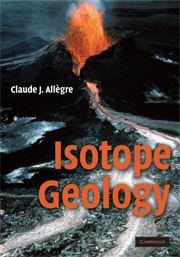Book contents
- Frontmatter
- Contents
- Preface
- Acknowledgments
- Isotopes and radioactivity
- The principles of radioactive dating
- Radiometric dating methods
- Cosmogenic isotopes
- Uncertainties and results of radiometric dating
- Radiogenic isotope geochemistry
- Stable isotope geochemistry
- Isotope geology and dynamic systems analysis
- References
- Appendix
- Further reading
- Solutions to problems
- Index of Names
- Subject Index
Isotopes and radioactivity
Published online by Cambridge University Press: 05 June 2012
- Frontmatter
- Contents
- Preface
- Acknowledgments
- Isotopes and radioactivity
- The principles of radioactive dating
- Radiometric dating methods
- Cosmogenic isotopes
- Uncertainties and results of radiometric dating
- Radiogenic isotope geochemistry
- Stable isotope geochemistry
- Isotope geology and dynamic systems analysis
- References
- Appendix
- Further reading
- Solutions to problems
- Index of Names
- Subject Index
Summary
Reminders about the atomic nucleus
In the model first developed by Niels Bohr and Ernest Rutherford and extended by Arnold Sommerfeld, the atom is composed of two entities: a central nucleus, containing most of the mass, and an array of orbiting electrons. The nucleus carries a positive charge of + Ze, which is balanced by the electron cloud's negative charge of −Ze. The number of protons, Z, is matched in an electrically neutral atom by the number of electrons. Each of these particles carries a negative electric charge e.
As a rough description, the nucleus of any element is made up of two types of particle, neutrons and protons. A neutron is slightly heavier than a proton with a mass of mn = 1.674 95 · 10−27 kg compared with mp = 1.672 65 · 10−27 kg for the proton. While of similar masses, then, the two particles differ above all in their charges. The proton has a positive charge (+ e) while the neutron is electrically neutral. The number of protons (Z) is the atomic number. The sum A = N + Z of the number of neutrons (N) plus the number of protons (Z) gives the mass number. This provides a measure of the mass of the nuclide in question if we take as our unit the approximate mass of the neutron or proton.
- Type
- Chapter
- Information
- Isotope Geology , pp. 1 - 28Publisher: Cambridge University PressPrint publication year: 2008



